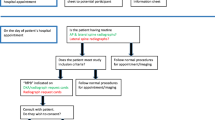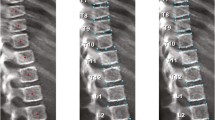Abstract
Summary
Six dual-energy X-ray absorptiometry (DXA) technicians reviewed lateral images of the spine for deformed vertebrae. The images were acquired with a DXA scanner in 235 patients referred for osteoporosis assessment. The outcome was compared to findings on spinal radiographs assessed by two radiologists. Three DXA technicians performed acceptable or better in identifying patients with fractured vertebrae.
Introduction
This is the first study to evaluate the accuracy of vertebral fracture assessment (VFA) when used by DXA technicians as a triage test to select patients with deformed vertebrae for spinal radiographs.
Methods
Lateral single-energy scans and radiographs of the thoracolumbar spine (T4–L4) were acquired in 235 patients aged 65 years or more referred for osteoporosis assessment. Six DXA technicians evaluated lateral scans using dedicated software. The DXA technicians were trained to identify deformed vertebrae, but they did not assess the aetiology of deformity. Two radiologists evaluated the radiographs and their consensus evaluation served as the reference test for vertebral fracture. The main outcome was sensitivity and specificity of the DXA technicians’ identification of patients with one or more grade II–III deformities according to Genant’s classification.
Results
The proportion of patients with one or more grade II–III vertebral fractures was 0.35. Sensitivity ranged from 0.61 to 0.83 and specificity ranged from 0.78 to 0.95 across the DXA technicians. In patients with grade II–III deformities on VFA, the mean probability of one or more grade II–III fractures was 0.74 (range 0.66–0.86). Conversely, in patients without such deformities, the mean probability of grade II–III fractures was 0.14 (range 0.10–0.18). Accuracy was lower for grade I–III deformities for all the DXA technicians.
Conclusion
Three of six DXA technicians achieved acceptable or better accuracy when using VFA to triage patients with grade II–III vertebral deformities for spinal radiographs. Heterogeneity between DXA technicians appears to be due to differences in subjective thresholds. VFA triage by DXA technicians to identify patients with grade II–III fractures is feasible.

Similar content being viewed by others
References
Ensrud KE, Schousboe JT (2011) Clinical practice. Vertebral fractures. N Engl J Med 364:1634–1642
Cummings SR, Melton LJ (2002) Epidemiology and outcomes of osteoporotic fractures. Lancet 359:1761–1767
Fink HA, Milavetz DL, Palermo L, Nevitt MC, Cauley JA, Genant HK et al (2005) What proportion of incident radiographic vertebral deformities is clinically diagnosed and vice versa? J Bone Miner Res 20:1216–1222
Klotzbuecher CM, Ross PD, Landsman PB, Abbott TA III, Berger M (2000) Patients with prior fractures have an increased risk of future fractures: a summary of the literature and statistical synthesis. J Bone Miner Res 15:721–739
Ensrud KE, Thompson DE, Cauley JA, Nevitt MC, Kado DM, Hochberg MC et al (2000) Prevalent vertebral deformities predict mortality and hospitalization in older women with low bone mass. Fracture Intervention Trial Research Group. J Am Geriatr Soc 48:241–249
Nevitt MC, Ettinger B, Black DM, Stone K, Jamal SA, Ensrud K et al (1998) The association of radiographically detected vertebral fractures with back pain and function: a prospective study. Ann Intern Med 128:793–800
O’Neill TW, Cockerill W, Matthis C, Raspe HH, Lunt M, Cooper C et al (2004) Back pain, disability, and radiographic vertebral fracture in European women: a prospective study. Osteoporos Int 15:760–765
Lunt M, O’Neill TW, Felsenberg D, Reeve J, Kanis JA, Cooper C et al (2003) Characteristics of a prevalent vertebral deformity predict subsequent vertebral fracture: results from the European Prospective Osteoporosis Study (EPOS). Bone 33:505–513
Siris ES, Genant HK, Laster AJ, Chen P, Misurski DA, Krege JH (2007) Enhanced prediction of fracture risk combining vertebral fracture status and BMD. Osteoporos Int 18:761–770
Murad MH, Drake MT, Mullan RJ, Mauck KF, Stuart LM, Lane MA et al (2012) Clinical review. Comparative effectiveness of drug treatments to prevent fragility fractures: a systematic review and network meta-analysis. J Clin Endocrinol Metab 97:1871–1880
Roux C, Baron G, Audran M, Breuil V, Chapurlat R, Cortet B et al (2011) Influence of vertebral fracture assessment by dual-energy X-ray absorptiometry on decision-making in osteoporosis: a structured vignette survey. Rheumatology 50:2264–2269
Diacinti D, Guglielmi G, Pisani D, Diacinti D, Argiro R, Serafini C et al (2012) Vertebral morphometry by dual-energy X-ray absorptiometry (DXA) for osteoporotic vertebral fractures assessment (VFA). Radiol Med 117:1374–1385
Lewiecki EM, Laster AJ (2006) Clinical review: clinical applications of vertebral fracture assessment by dual-energy x-ray absorptiometry. J Clin Endocrinol Metab 91:4215–4222
Bazzocchi A, Spinnato P, Fuzzi F, Diano D, Morselli-Labate AM, Sassi C et al (2012) Vertebral fracture assessment by new dual-energy X-ray absorptiometry. Bone 50:836–841
Binkley N, Krueger D, Gangnon R, Genant HK, Drezner MK (2005) Lateral vertebral assessment: a valuable technique to detect clinically significant vertebral fractures. Osteoporos Int 16:1513–1518
Chapurlat RD, Duboeuf F, Marion-Audibert HO, Kalpakcioglu B, Mitlak BH, Delmas PD (2006) Effectiveness of instant vertebral assessment to detect prevalent vertebral fracture. Osteoporos Int 17:1189–1195
Damiano J, Kolta S, Porcher R, Tournoux C, Dougados M, Roux C (2006) Diagnosis of vertebral fractures by vertebral fracture assessment. J Clin Densitom 9:66–71
Diacinti D, Del FR, Pisani D, Todde F, Cattaruzza MS, Diacinti D et al (2012) Diagnostic performance of vertebral fracture assessment by the lunar iDXA scanner compared to conventional radiography. Calcif Tissue Int 91:335–342
Domiciano DS, Figueiredo CP, Lopes JB, Kuroishi ME, Takayama L, Caparbo VF et al (2013) Vertebral fracture assessment by dual X-ray absorptiometry: a valid tool to detect vertebral fractures in community-dwelling older adults in a population-based survey. Arthritis Care Res 65:809–815
Fuerst T, Wu C, Genant HK, von IG, Chen Y, Johnston C et al (2009) Evaluation of vertebral fracture assessment by dual X-ray absorptiometry in a multicenter setting. Osteoporos Int 20:1199–1205
Hospers IC, van der Laan JG, Zeebregts CJ, Nieboer P, Wolffenbuttel BH, Dierckx RA et al (2009) Vertebral fracture assessment in supine position: comparison by using conventional semiquantitative radiography and visual radiography. Radiology 251:822–828
Lee JH, Cho SK, Han M, Lee S, Kim JY, Ryu JA et al (2014) Validity and role of vertebral fracture assessment in detecting prevalent vertebral fracture in patients with rheumatoid arthritis. Joint Bone Spine 81:149–153
Rea JA, Li J, Blake GM, Steiger P, Genant HK, Fogelman I (2000) Visual assessment of vertebral deformity by X-ray absorptiometry: a highly predictive method to exclude vertebral deformity. Osteoporos Int 11:660–668
Schousboe JT, Debold CR (2006) Reliability and accuracy of vertebral fracture assessment with densitometry compared to radiography in clinical practice. Osteoporos Int 17:281–289
Vokes TJ, Dixon LB, Favus MJ (2003) Clinical utility of dual-energy vertebral assessment (DVA). Osteoporos Int 14:871–878
Jager PL, Jonkman S, Koolhaas W, Stiekema A, Wolffenbuttel BH, Slart RH (2011) Combined vertebral fracture assessment and bone mineral density measurement: a new standard in the diagnosis of osteoporosis in academic populations. Osteoporos Int 22:1059–1068
Kuet KP, Charlesworth D, Peel NF (2013) Vertebral fracture assessment scans enhance targeting of investigations and treatment within a fracture risk assessment pathway. Osteoporos Int 24:1007–1014
Felsenberg D, Silman AJ, Lunt M, Armbrecht G, Ismail AA, Finn JD et al (2002) Incidence of vertebral fracture in Europe: results from the European Prospective Osteoporosis Study (EPOS). J Bone Miner Res 17:716–724
Genant HK, Wu CY, van KC, Nevitt MC (1993) Vertebral fracture assessment using a semiquantitative technique. J Bone Miner Res 8:1137–1148
Rea JA (1999) Vertebral morphometry studies using dual X-ray absorptiometry, appendix. In: Blake GM, Wahner HW, Fogelman I (eds) The evaluation of osteoporosis: dual energy X-ray absorptiometry and ultrasound in clinical practice, 2nd edn. Martin Dunitz, London, pp 429–459
Delmas PD, Genant HK, Crans GG, Stock JL, Wong M, Siris E et al (2003) Severity of prevalent vertebral fractures and the risk of subsequent vertebral and nonvertebral fractures: results from the MORE trial. Bone 33:522–532
Ettinger B, Black DM, Nevitt MC, Rundle AC, Cauley JA, Cummings SR et al (1992) Contribution of vertebral deformities to chronic back pain and disability. The Study of Osteoporotic Fractures Research Group. J Bone Miner Res 7:449–456
Pluijm SM, Tromp AM, Smit JH, Deeg DJ, Lips P (2000) Consequences of vertebral deformities in older men and women. J Bone Miner Res 15:1564–1572
Spector TD, McCloskey EV, Doyle DV, Kanis JA (1993) Prevalence of vertebral fracture in women and the relationship with bone density and symptoms: the Chingford Study. J Bone Miner Res 8:817–822
Armitage P, Berry G, Matthews JNS (2001) Analysing means and proportions. In: Statistical methods in medical research, 4th edn. Blackwell, Oxford, pp 83–146
Obuchowski NA (1998) Sample size calculations in studies of test accuracy. Stat Methods Med Res 7:371–392
Bossuyt PM, Reitsma JB, Bruns DE, Gatsonis CA, Glasziou PP, Irwig LM et al (2003) Towards complete and accurate reporting of studies of diagnostic accuracy: the STARD initiative. BMJ 326:41–44
Acknowledgments
Our DXA technicians were extremely passionate and enthusiastic about this task despite the fact that they to some extent were the guinea pigs. Without their willingness, this study could not have been conducted. Jesper Fries, senior radiologist, assisted in being one of the two readers of the spinal radiographs. Jørgen Hilden, senior biostatistician, supervised the sample size calculations.
Author information
Authors and Affiliations
Corresponding author
Ethics declarations
The study protocol was approved by the local ethics committee (J.nr. (KF) 01 271294). All patients gave written informed consent before study entry.
Conflicts of interest
None.
Electronic supplementary material
Below is the link to the electronic supplementary material.
ESM 1
(PDF 134 kb)
Rights and permissions
About this article
Cite this article
Rud, B., Vestergaard, A. & Hyldstrup, L. Accuracy of densitometric vertebral fracture assessment when performed by DXA technicians—a cross-sectional, multiobserver study. Osteoporos Int 27, 1451–1458 (2016). https://doi.org/10.1007/s00198-015-3395-4
Received:
Accepted:
Published:
Issue Date:
DOI: https://doi.org/10.1007/s00198-015-3395-4




